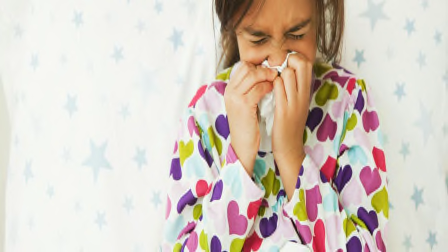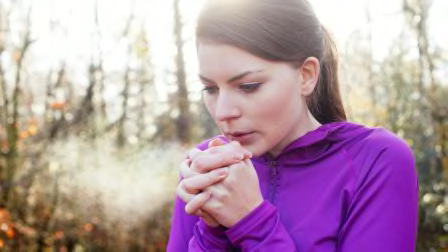Why People Get Colds in Quarantine
You're taking a million precautions to stay safe from COVID-19. So how did you end up with a common cold? Experts explain.

Even people taking a vast array of precautions to stay safe from COVID-19 might find themselves battling a more familiar foe: the common cold.
During a winter where the slightest cough can prompt a panicked trip to a coronavirus testing site, it’s important to understand how both of these infections work—and why you might find yourself with one even if you are relatively protected from the other.
One Virus vs. Hundreds
If we’ve learned one thing over the past several months, it’s that the coronavirus that causes COVID-19 is highly contagious. “But the virus that causes COVID-19 is just one, single virus,” says Catherine Troisi, PhD, an infectious disease epidemiologist at UTHealth School of Public Health in Houston. “On the other hand, there are hundreds of different viruses that can cause what we call the common cold.”
Some Cold Germs May Be Hardier
Getting a cold from one of the many rhinoviruses that causes them may be particularly easy—despite all our current precautions.
“Rhinoviruses are very hardy and survive really well on surfaces,” says Elizabeth Scott, PhD, professor of microbiology and an expert in home and community hygiene practice at Simmons University in Boston. The virus that causes COVID-19 is what’s called an “enveloped virus,” and it doesn’t live very long on surfaces. “It has a lipid membrane around it, but that layer breaks down very quickly, and the virus is killed,” says Scott. (That's one reason public health officials have de-emphasized the importance of surface cleaning in containing COVID-19 and emphasized the importance of masks and distancing.)
Studies have found that rhinoviruses can linger on surfaces (with enough potency to infect you) for more than 24 hours. They are also more likely to survive a swipe with hand sanitizer or a disinfecting wipe than the coronavirus that causes COVID-19.
Colds, like COVID-19, can be transmitted through the air. But if you’re catching colds this winter—despite vigilant mask-wearing and social distancing—you’re probably getting the germs from touching infected surfaces. “It could be as simple as touching a doorknob, a pen, or a shopping cart that someone with a cold has recently touched,” says Elizabeth Barnett, MD, an American Academy of Pediatrics infectious disease expert. “We still touch a lot of surfaces even if we’re only making essential trips.”
We're Not as Careful as We Think We Are
The No. 1 reason we’re still getting colds this winter (and part of why COVID-19 cases are still on the rise) is probably the simplest one: Even among people making a good faith effort to be careful, the precautions we’re taking aren’t—and in many cases can't be—perfect.
“I don’t want to discourage people from doing the things we know will help—like wearing masks, social distancing, and hand-washing—because those things do work,” says Scott. “But even those of us who think we’re being super careful should recognize that we still have chinks in the armor.”
For example, we may take off our masks in certain situations where they should stay on. We might be unable to avoid some face-to-face contact due to our jobs. We might touch infected surfaces then touch our faces without even realizing we're doing it. “It’s easy to miss these tiny interactions when we feel like we’re taking so many precautions,” Scott says.
It’s also important to remember that presymptomatic transfer happens with colds, just like it does with COVID-19. That's why—for both illnesses—avoiding sick people is not enough.
“You can be without symptoms and still spread the cold virus for 24 to 48 hours before you feel sick,” says William Schaffner, MD, professor of medicine and infectious diseases at Vanderbilt University School of Medicine. “If you’re around someone the day or two before they got sick, the virus can take advantage of that opportunity to transmit to you.”
Is It a Cold or COVID-19?
Experts say that the numbers of colds and flu are down this winter, but our awareness of the slightest sign of a cold is higher than ever. “We’re hyper-focused on any respiratory symptom,” says Scott. “We’re paying more attention to every sneeze and sniffle than we ever have before.”
And there’s a good reason for all that vigilance. “The symptoms of COVID clearly overlap with other infections—including the common cold and flu,” Barnett says.
Determining whether a sniffle or sore throat is just an annoying (but mostly harmless) cold or the potentially serious COVID-19 can be tricky. “An ordinary cold generally affects us from the neck up—stuffy, runny nose, headache, sore throat, maybe a mild cough or low-grade fever,” says Schaffner. “But if you feel the congestion move to your chest, have any trouble breathing, your cough becomes more persistent, or you have a fever over 100 degrees, you should call your healthcare provider.” (Learn more on the difference among symptoms of COVID-19, colds, and the flu.)
Schaffner also says that anyone who is at high-risk for COVID-19 complications should contact their doctor at the first sign of any possible symptoms. This winter, the best advice may be: When in doubt, get tested.




















